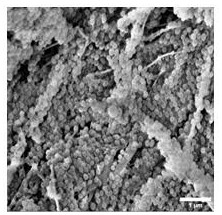Preparation method and application of acellular porcine dermal matrix thermosensitive antibacterial conductive scaffold
A technology of acellular porcine dermis and conductive scaffold is applied in the field of preparation of acellular porcine dermal matrix thermosensitive antibacterial conductive scaffold, which can solve the problems of large skin defect and high recurrence risk of surgical operation, and achieves the promotion of cell growth and wound promotion. The effect of tissue healing
- Summary
- Abstract
- Description
- Claims
- Application Information
AI Technical Summary
Problems solved by technology
Method used
Image
Examples
Embodiment 1
[0053] 1) Preparation of polystyrene emulsion: Weigh 1.0g of polyvinylpyrrolidone in 0.5L of ultrapure water, transfer to the reactor after the polyvinylpyrrolidone is completely dissolved, add 50g of styrene, purge with nitrogen for 10min, and heat to 50 ℃ and constant temperature stirring for 10min; adding 5.0mL of 2,2'-azobisisobutyramidine hydrochloride, nitrogen protection for 1h to obtain a polystyrene emulsion.
[0054] 2) Preparation of hollow silica microspheres: Weigh 0.1 g of cetyltrimethylammonium bromide powder and dissolve it in a mixed solution of 5.0 g of ultrapure water, 5.0 g of ethanol and 1.0 mL of ammonium hydroxide; stir vigorously Add 5.0 g of the above polystyrene emulsion, ultrasonicate for 5 min, and stir at room temperature for 10 min; take 0.1 g of ethyl orthosilicate slowly dropwise into the reaction system, and continue to stir for 0.5 h; centrifuge the obtained mixed solution at 5000 rpm for 5 min, use a large amount of The product was washed wit...
Embodiment 2
[0060] 1) Preparation of polystyrene emulsion: Weigh 2.0g of polyvinylpyrrolidone in 0.8L of ultrapure water, transfer to the reactor after the polyvinylpyrrolidone is completely dissolved, add 80g of styrene, purge with nitrogen for 30min, and heat to 80 ℃ and constant temperature stirring for 30min; adding 10.0mL of 2,2'-azobisisobutyramidine hydrochloride, nitrogen protection for 12h to obtain a polystyrene emulsion.
[0061] 2) Preparation of hollow silica microspheres: Weigh 0.8g of cetyltrimethylammonium bromide powder and dissolve it in a mixed solution of 10.0g of ultrapure water, 10.0g of ethanol and 2.0mL of ammonium hydroxide; stir vigorously 25.0 g of the above polystyrene emulsion was added, sonicated for 10 min and stirred at room temperature for 30 min; 1.5 g of ethyl orthosilicate was slowly dropped into the reaction system, and stirred for 0.5 h; the obtained mixed solution was centrifuged at 7000 rpm for 15 min, and a large amount of The product was washed wi...
Embodiment 3
[0067] 1) Preparation of polystyrene emulsion: Weigh 5.0 g of polyvinylpyrrolidone in 1.0 L of ultrapure water, transfer it to the reactor after the polyvinylpyrrolidone is completely dissolved, add 100.0 g of styrene, purge with nitrogen for 60 minutes, and heat to 100 ℃ and constant temperature stirring for 60min; adding 50.0mL 2,2'-azobisisobutyramidine hydrochloride, nitrogen protection for 24h to obtain a polystyrene emulsion.
[0068] 2) Preparation of hollow silica microspheres: Weigh 2.0 g of cetyltrimethylammonium bromide powder and dissolve it in a mixed solution of 20.0 g of ultrapure water, 20.0 g of ethanol and 5.0 mL of ammonium hydroxide; stir vigorously 50.0 g of the above polystyrene emulsion was added, sonicated for 50 min and stirred at room temperature for 60 min; 2.0 g of ethyl orthosilicate was slowly dropped into the reaction system, and stirred for 3.0 h; the obtained mixed solution was centrifuged at 1000 rpm for 30 min, and a large amount of The produ...
PUM
| Property | Measurement | Unit |
|---|---|---|
| diameter | aaaaa | aaaaa |
| size | aaaaa | aaaaa |
| thickness | aaaaa | aaaaa |
Abstract
Description
Claims
Application Information
 Login to View More
Login to View More - R&D
- Intellectual Property
- Life Sciences
- Materials
- Tech Scout
- Unparalleled Data Quality
- Higher Quality Content
- 60% Fewer Hallucinations
Browse by: Latest US Patents, China's latest patents, Technical Efficacy Thesaurus, Application Domain, Technology Topic, Popular Technical Reports.
© 2025 PatSnap. All rights reserved.Legal|Privacy policy|Modern Slavery Act Transparency Statement|Sitemap|About US| Contact US: help@patsnap.com



